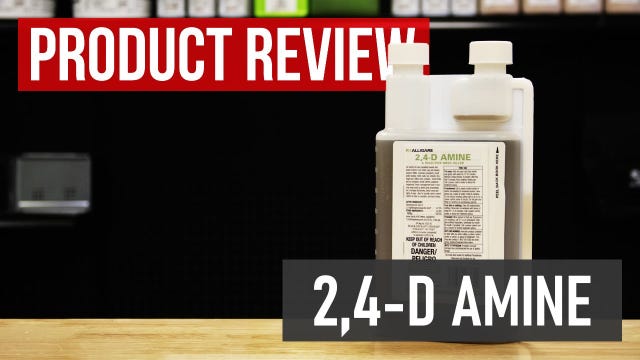Gain access to personalized product screening, the best pricing, rewards, and more!
Most Effective Products
Broadleaf Weeds Have No Chance Against 2, 4-D Weed Killer
“2, 4-D" looks like a weird mashup of letters and numbers to the average American. However, to those in the agricultural industry or are turf and lawn experts, 2, 4-D is regarded as one of the most helpful chemicals in eliminating troublesome broadleaf weeds.
2, 4-D is perhaps the most utilized broadleaf weed killer worldwide and is among the top three most used herbicides for residential and commercial lands. 2, 4-D comes in various formulations--from liquids to dust and granules.
Solutions Pest & Lawn is proud to carry 2, 4-D Amine Selective Weed Killer, one of our best-selling herbicides. It works!
Learn more about the history and science behind this tremendous herbicide in this informative article.
The Origins of 2, 4-D
There is an interesting story about how 2, 4-D came to be. The chemical mixture was believed to have been developed by scientist Dr. Franklin D. Jones, who initially wasn’t trying to come up with the weed killer to make money but rather to combat the effects of poison ivy that was growing in his yard and his children were very sensitive to the plant.
His experimentation led him to the naturally occurring plant growth hormone indoleacetic acid (IAA). However, Dr. Jones found that the chemical was far too unstable. He needed a stable synthetic alternative that he could experiment with. The synthetic version he developed was 2, 4-D.
Dr. Jones developed more than just the world’s first selective herbicide. He created a fantastic solution to human problems such as food scarcity, infrastructure management, and invasive and potentially poisonous weeds.
The development of 2, 4-D is regarded by the Henry Ford Organization as one of the top 75 innovations in the last 75 years. 2, 4-D continues to tackle weed problems as one of the most widely used herbicides worldwide.
Over the years since its development in the early 1940s, 2, 4-D has evolved scientifically to meet regulations set by the US EPA, the European Commission, and other regulators. In the last 60 years, over 40,000 different research studies have been done on 2D and 4D, which has gone down as one of the most researched chemicals in history. This large amount of research was not just for its role in pioneering the field of selective herbicides but also to ensure it meets the world’s modern human health standards.
2, 4-D: The First “Selective” Herbicide

2, 4-D is regarded as the world’s first selective herbicides because when applied to plants, it suppresses "dicots" (plants with two seed leaves, also known as broadleaf plants) while leaving "monocots" unaffected (plants with one seed leaf or thin leaves).
This means it isn’t a kill-all herbicide and can be sprayed on grasses and plants like wheat, corn, rice, and other crops without harming them. It only kills the broadleaf weeds.
Why 2, 4-D Weed Killer is so Effective

It is fascinating how 2, 4-D works as a weed killer of broadleaf weeds. It essentially creates disorder in the broadleaf plant it is sprayed upon, causing it to grow uncontrollably to the point that it dies. This occurs because the chemical creates a sort of unregulated growth that destroys the broadleaf weeds' vital tissues.
2, 4-D is a selective weed killer, which means it only affects broadleaf weeds and not grasses. These two different classifications of plants work differently when it comes to chemicals that move through their leaves. While broadleaf weeds have their growing point at the tips of the leaves, grasses grow from the base. Thus, the 2, 4-D herbicide can kill broadleaf weeds while sparing desired grasses.
Another reason 2, 4-D is such a popular product is that it is very affordably priced and works quickly to kill problem weeds. Over 1,500 herbicide products contain 2. 4-D, and it's often mixed with other active ingredients like dicamba.
A typical application of 2,4-D can kill weeds like dandelion, clover, crabgrass, and other invasive grassy and broadleaf weed species in as quickly as 2 months.
Toxicity Concerns of 2, 4-D
As noted earlier, 2, 4-D has been studied and widely researched by scientists. Concerns have been raised about its toxicity and how it can affect the health of the environment and humans. Some have stated that using 2, 4-D carries the risk of spreading carcinogens, which can “possibly” cause cancer.
However, there have been conflicting reports, and 2, 4-D Amine has relatively low toxicity compared to other pesticides.
2, 4-D Amine is safe to use. As long as you wear the proper safety gear and equipment when handling this product, you will have nothing to worry about when applying it to your lawns.
Key Takeaways
What weeds does 2,4-D Kill?
- Whether it’s a harmful weed like poison ivy or an unsightly broadleaf weed like dandelion, stinkweed, or clover, using 2, 4-D Amine Selective weed killer is highly recommended to keep your lawn looking neat and uniform.
How does 2,4-D Work?
- Use 2,4-D as a spot treatment for any emerging weeds you don’t want growing on your property. They should die within 2 weeks.
- Solutions Pest & Lawn offers 2,4-D at an amazing value, so if you’re in a weed-tackling mood, you can’t go wrong with 2,4-D Amine. Equip yourself with 2, 4-D Amine today and kill those pesky weeds!
Want more Information on 2,4-D?
- If you need any further DIY advice on how to best apply 2,4-D herbicides to your lawn, we are always available to help via phone, online live chat, or email.







